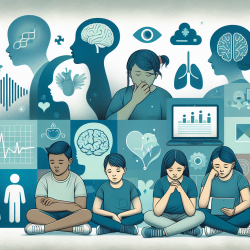Introduction
In the realm of speech-language pathology, understanding the multifaceted factors that influence a child's mental and physical health is crucial. A recent study titled "Modeling of Longitudinal Polytomous Outcome from Complex Survey Data - Application to Investigate an Association between Mental Distress and Non-Malignant Respiratory Diseases" provides valuable insights into the complex interplay between mental distress and respiratory health. This blog aims to explore these findings and discuss their implications for practitioners working with children.
Understanding the Research
The study utilized data from Statistics Canada's National Population Health Survey (NPHS) to examine the relationship between mental distress and respiratory diseases such as asthma and chronic bronchitis. The researchers employed sophisticated statistical models to analyze the data, accounting for the complex survey design and repeated measurements over time.
Key findings from the study include:
- A significant association between chronic bronchitis and increased mental distress.
- No significant association between asthma and mental distress when adjusted for other variables.
- A notable interaction between sex and self-perceived general health, indicating that females with deteriorating health reported higher levels of mental distress.
Implications for Practitioners
For practitioners in speech-language pathology, these findings underscore the importance of a holistic approach to child health. Here are some actionable insights:
- Comprehensive Assessments: Incorporate assessments that evaluate both mental and physical health, particularly focusing on respiratory conditions and their potential impact on mental well-being.
- Interdisciplinary Collaboration: Collaborate with healthcare providers to ensure a comprehensive understanding of a child's health status, facilitating better-informed therapeutic decisions.
- Tailored Interventions: Develop intervention plans that consider the child's overall health, including strategies to manage stress and anxiety that may arise from chronic health conditions.
Encouraging Further Research
The study highlights the need for further research to explore the nuances of the relationship between mental distress and respiratory diseases in children. Practitioners are encouraged to engage in or support research efforts that aim to deepen our understanding of these complex interactions.
Potential areas for future research include:
- Longitudinal studies that track mental health outcomes in children with respiratory conditions over time.
- Investigations into the role of socio-economic factors and their influence on the mental health of children with respiratory diseases.
- Studies exploring the effectiveness of integrated therapeutic approaches that address both mental and physical health needs.
Conclusion
As practitioners dedicated to improving outcomes for children, it is essential to remain informed about the latest research and its implications for practice. The study on mental distress and respiratory diseases provides a valuable framework for understanding how these factors intersect and influence child health. By integrating these insights into practice, practitioners can enhance their ability to support the well-being of children in their care.
To read the original research paper, please follow this link: Modeling of longitudinal polytomous outcome from complex survey data - application to investigate an association between mental distress and non-malignant respiratory diseases.










